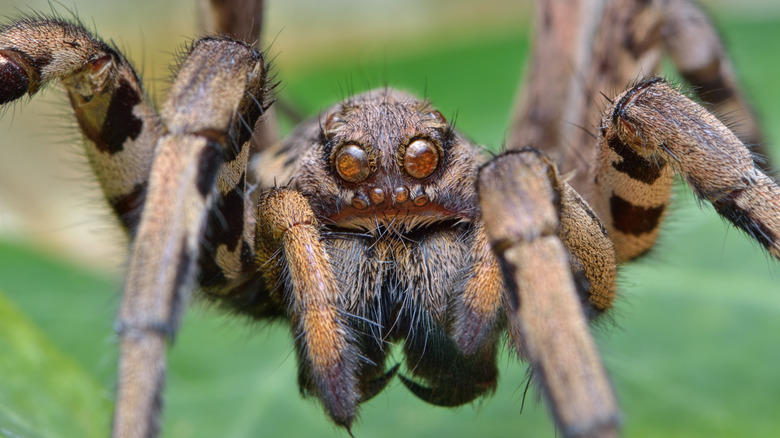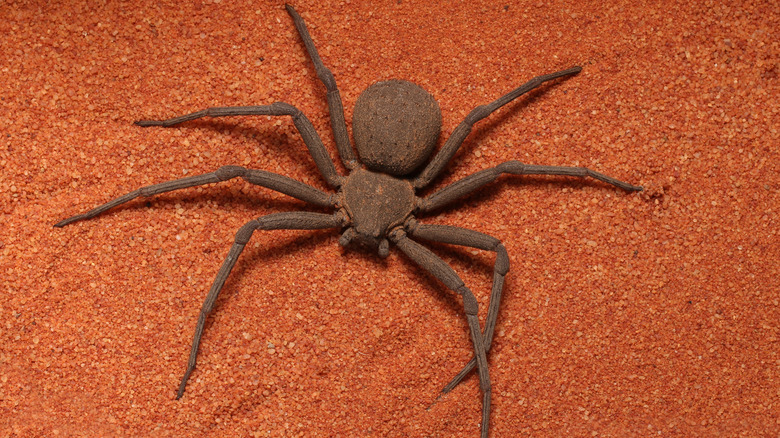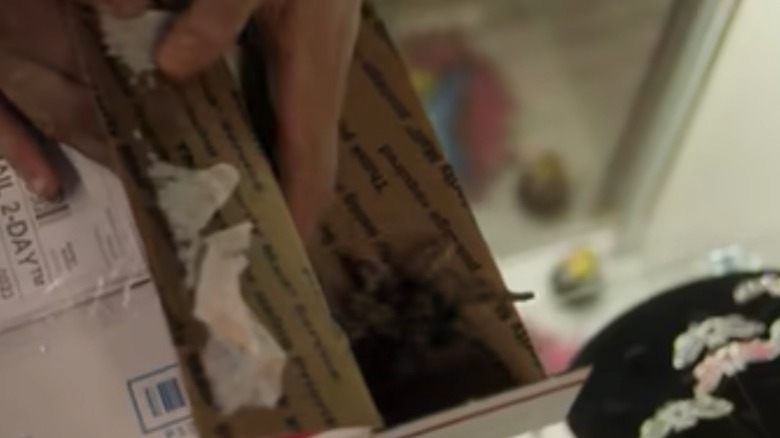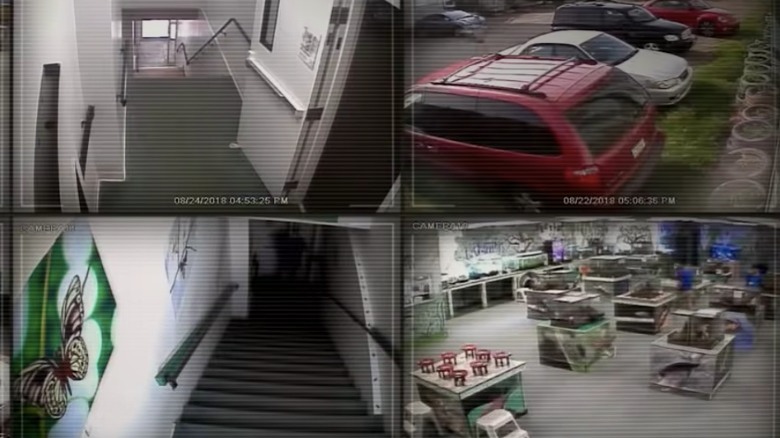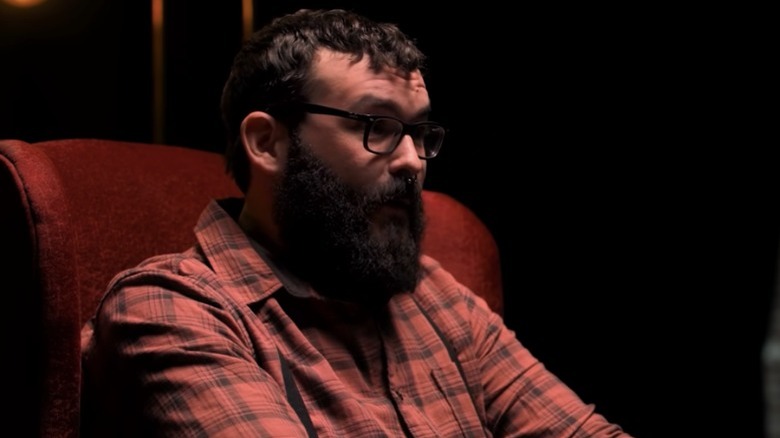The Truth About The Unsolved Exotic Bug Heist Totaling $50,000
We may receive a commission on purchases made from links.
The Philadelphia Insectarium and Butterfly Pavilion has been a highly popular destination for family day outs and school visits since it was first opened back in 1992. Originally, the museum was created as the offshoot of a bug extermination company run by entrepreneur Steve Kanya, whose instinctive gift for publicity saw the attraction grow its customer base with gross-out attractions such as the "roach kitchen," a freestanding kitchen unit overrun with the creepy house pests.
Educational but with a sensational twist, the insectarium had grown to span three whole warehouse floors by the time it became the focus of a dramatic and bizarre news story back in 2018 when newspapers reported that the site was the target of an audacious heist. As reported by The Washington Post, more than 7,000 of the insectarium's prize specimens — all of which were live — were stolen over the course of four days.
The story made local, national, and international news, with most outlets leading with the same rather obvious question: Why?
A horrifying haul
According to The Washington Post, the 2018 robbery at the Philadelphia Insectarium and Butterfly Pavilion was believed to be the biggest heist of living insects on record by the museum's CEO, John Cambridge. The 7,000 specimens he claimed were taken represented some 80% of the museum's entire inventory, while the creatures that were taken were believed to be worth a total value approaching $50,000.
As the Philadelphia Insectarium heist made waves in the media, many outlets focused on one specimen in particular to give the story a creepy focal point: the six-eyed sand spider (pictured). The creature received specific attention on social media and news channels as well as in the police department following a joke about the creature by Jimmy Kimmel. According to police detective Mike Zanetich, an investigator on the case who was interviewed for the IMDb TV documentary series "Bug Out," it was suggested that the spider could be used in a terror attack, and investigators faced great pressure to get the spider back. As John Cambridge described in an interview for "Bug Out," a single bite from a six-eyed sand spider would be enough to kill. "It could rot 25% of their body," Cambridge claimed.
The dark world of insect trafficking
It may seem strange that a collection of bugs could be worth a small fortune, but as "Bug Out" shows, there is a large market for creatures — including spiders, beetles, stick insects, and more — that the average animal lover would never dream of keeping in their home. While there are stringent laws in place to control the circulation of dangerous or potentially invasive bugs within U.S. territories (strictly enforced by the U.S. Fish and Wildlife Service), "Bug Out" reveals that illegal insect trafficking is a huge business, with sales occurring at insect fairs as well as through the practice of "brown boxing" — the distribution of controlled insects anonymously through the U.S. postal service.
Karen Verderame, an entomologist at the Academy of Natural Sciences of Drexel University, told The Washington Post: "If you're trying to ship a monkey, that's a whole other story, right? But an insect, you can put it in a box with insulation and claim that it's something else. Unless they have reason to open up that parcel, for all they know, it's what you say it is. It's that easy." Per the same source, many of the creatures stolen from the insectarium could fetch hundreds of dollars each on the black market. According to the insectarium CEO John Cambridge, who spoke to The Washington Post in 2018, the exotic pet trade was "bursting" at the time of the theft, with many of the center's top exhibits fetching a large price from private buyers.
But how was the Philadelphia Insectarium connected to this underground bug trading scene? Through the museum's expert entomologist, Wlodek Lapkiewicz.
Possible suspects
As described in "Bug Out," Wlodek Lapkiewicz was known by his colleagues at the Philadelphia Insectarium as a highly knowledgeable and gifted insect keeper and breeder. After joining the facility as director of the animal care department, he trained others around him in the art of husbandry and greatly multiplied the number of specimens on show through his highly effective breeding techniques.
According to John Cambridge, Lapkiewicz was also known for being able to procure any species the museum could possibly want. And through his black market connections, he would certainly have known how best to turn a profit from such an audacious and specialized theft. But as the documentary notes, Lapkiewicz had long since left the insectarium by the time of the theft, having turned his attention to making a living from trading bugs full-time.
Investigators thus drew up a list of other suspects, including handyman Michael Kinzler — who had previously been convicted of stealing from an employer, according to "Bug Out" — and Steve Kanya, the founder of the insectarium who had spent years in legal wrangles with Cambridge over ownership of the business. Kinzler was at the time owed a good deal of back pay from the museum, while Kanya, having lost his case against Cambridge, may have sought his own revenge.
But the obvious perpetrators, according to Cambridge at least, were a group of current employees from the animal care department who quit abruptly at the time of the heist and who signposted their disdain for the museum by leaving behind their insectarium uniforms ... stabbed into the wall of the museum office with kitchen knives.
Caught red-handed?
In the first episode of "Bug Out," Philadelphia Insectarium CEO John Cambridge explains the difficulties he had finding a diligent team for the museum's animal care department, calling the department as a whole a "problem child." After the loss of Wlodek Lapkiewicz, Cambridge sought another bug expert to take over the directorship of the department. The role went to Chris Tomasetto, a young bug enthusiast with the same collecting and trading hobby as Lapkiewicz. However, it soon became evident that Tomasetto and Cambridge didn't see eye-to-eye, and a power struggle began to emerge between the two men, who each attracted their own groups of supporters and detractors within the museum.
For Cambridge, it was certain that Tomasetto, his colleague and partner Alison Mumper, and a number of other animal care staff had systematically robbed the museum of 80% of its creatures, motivated by spite and, possibly, money. As shown in "Bug Out," and as Cambridge described at the time of the theft (via ABC News), Tomasetto and his friends were seemingly caught red-handed, with an abundance of security camera footage showing employees — including two figures who are unmistakably Tomasetto and Mumper — carrying large bins of the museum's collection to their cars and driving them away.
But Cambridge also noted that the thieves may have plunged themselves into deeper trouble. "We had eight tarantulas that we were holding as evidence for a smuggling trial," Cambridge told ABC News, suggesting that whoever committed the heist at the insectarium had inadvertently stolen evidence in a federal case, which meant the FBI would have to get involved.
Stolen goods ... or private property?
It seems wild that the case against Chris Tomasetto and his coterie of insect thieves seems so strong, yet neither he nor his accomplices have ever faced justice for the famous heist at the Philadephia Insectarium. Most news sources, such as The Philadelphia Inquirer, still refer to the case as "unsolved." So why didn't the authorities do anything?
As the final episode of "Bug Out" reveals, the heist may not have been as clear-cut as it first appeared. Tomasetto himself sat down for an interview with director Ben Feldman looking to "set the record straight," and he presented a very different set of events than was originally described back in 2018. According to Tomasetto, the Philadelphia Insectarium was severely underfunded during his tenure, and as such, Tomasetto and several other members of staff took it upon themselves to populate the depleted exhibits with specimens from their own private collections. When they left, they simply took their own property with them, according to Tomasetto.
In response, John Cambridge argued that company policy stated that all bugs brought to the insectarium became the museum's property, even though there was no evidence of this in the employee handbook, and employees contested that this was in any way an oral agreement between the staff and CEO. "Bug Out" also reveals that Cambridge has failed to prove the insectarium was housing evidence for a federal smuggling case, while Tomasetto claims that the true number of bugs taken from the insectarium in 2018 was actually in the hundreds, rather than the 7,000 many news outlets claimed.
No one has yet been charged with any wrongdoing.
